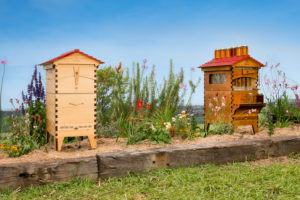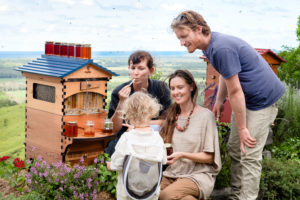What began as a hobby, passed down from generation to generation, has since turned into a revolution among beekeepers. Father and son duo, Stuart and Cedar Anderson, have been keeping bees for most of their lives. According to Cedar, people often ask if they ever think of giving it up, to which the answer is always no. Instead, they took nearly a decade to create and develop a beehive that releases honey via a tap, without needing to handle the bees, called Flow Hive.
Bees are fascinating creatures, and unfortunately in need of saving. According to Greenpeace, honeybee colonies have decreased nearly 60 per cent since 1947. The decline is likely due to the increased use of pesticides in crops and parasites that thrive in bee colonies. “We need to save the honeybees,” Cedar urges, “Not for the selfish reason of having food types on our supermarket shelves, but because if we can’t provide a world where honeybees can survive, we are going to lose many species and eventually find it hard to survive ourselves.”
Since it’s release, Flow Hive has received vast amounts of praise and criticism but has also been credited as revolutionizing beekeeping. It also has encouraged a new generation of beekeepers, and hopefully a resistance to the global honeybee decline. We spoke more with Cedar about Flow Hive and how it’s efforts toward sustainability are helping the bees.
Tell us a little about Flow Hive.
Cedar Anderson: The Flow Hive started with the thought, “There has to be an easier way.” I was extracting honey in the conventional fashion, a labour intensive process that would take all weekend making a big, sticky mess in the shed.
I thought there had to be a better way that is gentler for the bees and a lot easier on the beekeeper. So, I came up with the concept of being able to turn a tap on the beehive and have the honey flow straight out.
Inventing the Flow Hive was a process trying, failing, and trying again. It took extreme amounts of perseverance and optimism to carry an idea into a disruptive technology that can change the world. Since then, I’ve learned business is a game of perseverance and problem-solving to overcome obstacles. Many thought what we had invented wasn’t even possible, wouldn’t work. Many thought we’d never be able to start from scratch and be able to make and deliver 25,000 hives in an eight-month period.
How does it work?
CA: The Flow Hive differs from a conventional beehive in a major way: it contains our Flow frame in the honey super. Otherwise, the beehive is pretty similar – the brood box, the queen still doing her thing on wood and wax, the bees having their babies as usual. And then we come along with our Flow frames and put them on top.
There’s a plastic foundation, or party-drawn foundation matrix, that the bees cover in wax and build their comb onto to create the honeycomb. Then we come along from the outside, insert something that looks like a long Allen key, turn it, and channels from inside the comb allow the honey to flow inside of the frame into the trough in the bottom and through a tube into your jar. What that means is that at the turn of a handle, you’ve got beautiful, fresh honey flowing out of your hive into your jar that needs no further processing.
How does that compare to traditional beekeeping?
CA: If you compare Flow Hive to a traditional set up, you have to get in a bee suit, smoke the bees, pull apart the hive, take those frames out and take them to a processing shed or laundry, cut the wax capping off the frames with a heated knife, put those frames into a centrifugal extractor, spin that up to a high speed, and spin the honey out. [After that, you may have to process and filter the honey if any wax or bee bits travel with it.]
If that’s not enough work, you have to then go back to the hives, get in your bee suit again, pull the hive apart, put those frames back in the same hive (so not to spread disease), and the process starts again.
[With Flow Hive], at the turn of a handle, you’ve cut out many hours of hot, sticky work pulling apart the hive. It’s not hard to squash bees when you’re doing that conventional processing, and it just changes the experience to a turn-handled solution.
Let’s talk about bees: Some complaints about beekeeping for honey suggest tapping for honey takes the caring for bees aspect of beekeeping out of the equation. You guys seem to care about bees and protecting them, so what would you say to someone with that worry?
CA: There are some people who keep bees and don’t want to harvest honey, just keep them for pollination. But I’d say the majority of people keep bees because of their extraordinary ability to bring in honey. Wasps also live in colonies and can pollinate, but they don’t seem to be so attractive to keep. So most beekeepers start off keeping bees because of the honey. Then some of them find beekeeping so fascinating they end up keeping them for other reasons—to learn how the hive works and the intricate nature of how they work together as a colony, and their ability to pollinate.

The Flow Hive attracted a lot of attention in the beginning. It also inspired a new wave of amateur beekeepers, and we’re so happy to say many of our new beekeepers are becoming so fascinated with the bees. They’re doing a fantastic job looking after and caring for the bees, and we’ve taken it upon ourselves to create online content for people to learn from, and I answer questions from new beekeepers live every week.
So contrary to initial fears, we have a whole new wave of excited and caring beekeepers in the world. If we look after the bees, they’ll look after us…and the honey is an amazing bonus.
On the same note, another complaint is that beekeeping disrupts the bees and creates stress. How do your products work in favor of the bees?
CA: We invented the Flow Hive because we wanted a honey harvesting process without the disruptive, conventional method. With it, you can often harvest honey behind the hive without the bees even noticing it’s happening. They go about their usual business. We achieved our goal of harvesting honey in a way far less stressful for the bees. And when the bees are less stressed, they’re less susceptible to pests and disease.
Sustainability and environmental protection go hand in hand, and that includes beekeeping. Is it a sustainable effort?
CA: The great thing about beekeeping, and one of the things that drives us to keep producing hives and sending them into the world, is when people become a beekeeper, they can’t help but start to see the world in a different way, noticing what’s flowering, the effect of what something has on our environment and ecosystem.
Honeybees need an ecosystem that has diversity of pollen. Pollen are their protein, and nectar is their carbohydrate. If they’re fed only one, they’ll get sick like us. And bees also need an environment free from lethal insecticides.
For us, each hive we post out is a window into the world, and the interconnectedness of all things that we completely depend on. So yes, sustainability is something we’re completely passionate about.
How are the materials you use more sustainable than other options on the market?
CA: Almost everything we do in our lives have ramifications on our earth and our natural resources. We think about this a lot, and it’s why we’ve recently become a B Corp. But it’s only the beginning.
Humans have a long way to go before we can truly say that what we do day to day is sustainable. The transition we need to make is something we have to continue forever. So when it comes choosing components for our Flow Hives, we look into it deeply and make the most sustainable options we can find.

For wood components, that means making sure the harvesting operations are sustainable. And for plastic components, making sure they are long lasting and closed look recyclable. For our hives, making sure we’re choosing the very best plastics when it comes to food contact, even though the bees cover all the components in wax.
Plastic foundations have been used for decades in conventional beekeeping, but they haven’t always been made out of the best plastics. We considered all sorts of materials, glass vs. metal, etc., but plastic is the best option, specifically polypropylene.
Polypropylene was a good choice because, while it isn’t as strong as other plastics, it’s the best food-grade plastic we could find. The materials for the clear faces were important, and we chose copolyester, because that’s what is used in babies’ bottles and it’s free from BPA and BPS or any bisphenol products.
For the rest of the hive, we decided to keep it as natural as possible, using wooden materials and wooden frames and letting the bees naturally draw their comb from the frames, rather than providing any plastic in the brood box.






